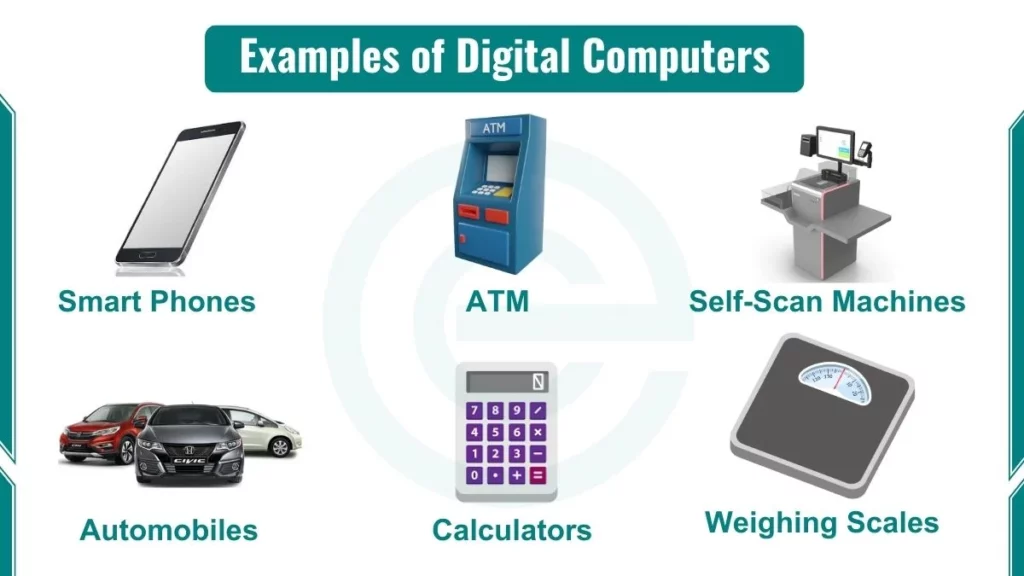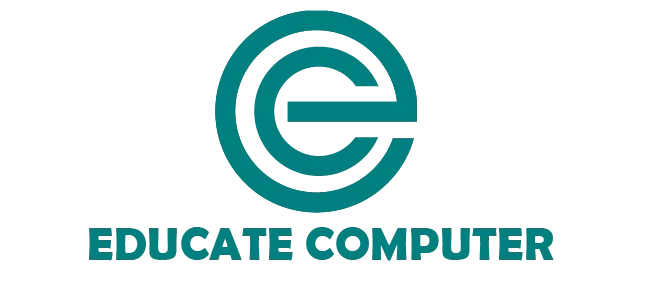Examples of digital computers include Smartphones, Digital clocks, ATMs, Calculators, Automobiles, Digital Televisions, and more.
Digital computers are programmable electronic devices that manipulate data represented as binary digits (0s and 1s) to perform calculations, analyze information, control processes, and more.
Also Read: Examples of Analog Computer
Examples of Digital Computers
Here are the best real-life examples of digital computers:

1. Smart Phones
The pocket-sized computers we carry with us everywhere are one of the most obvious and impactful examples of a digital computer. Modern smartphones are powerful computers that also can make calls.
With mobile processors faster than some laptops, internet connectivity, high-resolution touch screens, cameras, and a variety of sensors. Smartphones present the digital computer’s versatility.
Fact: Estimates for the total number of smartphone users in 2024 range from 6.6 billion to 6.84 billion.
2. ATM (Automated Teller Machine)
When you need quick cash, you most likely head to the nearest ATM. ATMs are technological digital computers designed specifically for bank transactions.
Connected via networks to your bank’s computer systems, ATMs can access your account information to allocate cash using different authentication methods. Many ATMs even accept check and cash deposits.
Fact: There are over 3.4 million ATMs installed globally.
3. Banking and Finances
From online banking websites and apps to accounting software, digital computers are necessary for running modern financial institutions and managing money. Sensitive financial data is stored, accessed, and updated using servers, software, and databases. Digital computers track balances, enable electronic funds transfers and power stock markets.
Fact: Online/mobile banking grows 14% year-over-year
4. Automobiles
Cars have developed from purely mechanical devices to complex digital computers on wheels. Modern vehicles contain multiple digital computers monitoring and controlling necessary systems like the engine, transmission, brakes, airbags, etc.
They are connected via internal networks to sensors, actuators, and user interfaces like dashboard infotainment centers.
Fact: A typical new car has between 50-100 microprocessors on board.
5. Self-Scan Machines
Self-checkout machines at retail stores allow consumers to scan, bag, and pay for items themselves, enabled by scales, scanners, and touchscreen computers. It enables shoppers to digitally scan purchases and complete transactions independently.
Fact: Self-checkout sales are expected to grow to over $325 billion by 2025.
6. Home Electronic Equipment
Many common household devices rely on digital computers to function. Television sets, DVR cable boxes, streaming media players, voice-controlled smart speakers, thermostats, and security systems.
Even some appliances have integrated processors, memory, software, sensors, and internet connectivity. They can be controlled remotely via home networks and apps.
Fact: Over 80% of U.S. households own at least one smart home device
7. Digital Televisions
The shift from analog to digital TV broadcasting revolutionized television technology. Modern HDTVs use specialized computers and processors to decode digital signals into video and audio.
Digital formats allow for HD (high definition) picture quality, widescreen aspect ratios, surround sound audio, and interactive capabilities using only a standard antenna.
Fact: As of 2020, 98% of American households have at least one digital TV.
8. Digital Pianos
Digital pianos use digital signal processors and built-in recording systems to produce realistic piano sounds without metal strings or sounding boards. Players use a keyboard to control this.
Fact: Over 50% of pianos sold annually in the U.S. are digital.
9. Weighing Scales
Digital scales and weigh stations show simple single-purpose computers. Weight measurements are made using electronic load cells and converted to digital numbers indicating mass or weight.
Features like BMI measurement, recall of previous weights, and data tracking over time demonstrate their computational abilities.
Fact: The first digital scale was patented in the 1970s, replacing old spring scales.
10. Calculators
Electronic calculators are small, specialized digital computers. Built around processor chips optimized for mathematical operations like addition, subtraction, multiplication, and dividing numbers entered via keypads.
More advanced models support exponents, square roots, logarithms, and trigonometric functions for scientific and financial use.
Fact: Between 1965 and 1975, electronic calculator sales increased from just a few thousand to over a million units per year.


